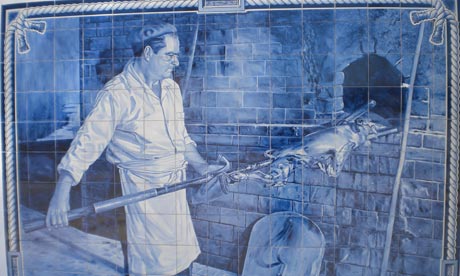
Few Portuguese meals seem to pass without the transportation of pork from plate to lips. Bowls of thick caldo verde, traditional cabbage soup, are plumped out with slices of chouriço (sausage). Cubes of shoulder are braised with clams, oregano, garlic, and white wine to make the delicious porco à alentejana, or even served pickled in red wine, garlic and chillies as carne de vinha d'alhos, a dish that is the progenitor to the vindaloo from the former Portuguese colony of Goa. Chunks of leg meat are impaled on skewers to be cooked over hot coals and, just in case the locals demand a more portable source of dead pig, the almost endless supply of bakeries in every town sell loaves of bread studded with chunks of fatty ham.
But lording it over all of these dishes in the affections of the Portuguese is the leitão assado da bairrada, suckling pig roasted and basted until the flesh is creamy and the skin develops a prerequisite crunch. Leitão assado is to be found on menus throughout Portugal but, if you want to experience the dish at its very best, you should head to the Bairrada wine region and in particular to the small town of Mealhada, about half way up the country around 10 miles from the coast.
At first sight, Mealhada appears an unlikely location for a food pilgrimage. It has a population of little over 5,000 and while its small network of streets and squares offers a pleasant enough diversion for the visitor, they give little clue as to why Portuguese families flock here every weekend, save an ornamental fountain whose blue tiled designs show a cook placing a suckling pig into a wood-burning oven.
But the garish signs and large car parks of the more than two dozen restaurants that line either side of the main road give a further clue, and the reoccurrence of the word leitão leaves you in no doubt what you'll find in these places. Among the more well known are Pic-Nic Dos Leitões, Restaurante Rei Dos Leitões, Meta Dos Leitoes, Tres Pinheirros Dos Leitoes and, perhaps most famous of all, Pedro Dos Leitões, the restaurant which started it all. Álvaro Pedro opened his first shop in 1943 to sell pork sandwiches to hungry truck drivers. By 1949, his business was successful enough for him to open his eponymous restaurant, which is still family run and has now grown to the point where it can feed more than 400 people in a sitting and prepare over 100 pigs a day. Its success led to the opening of rival restaurants, and soon Mealhada's reputation as hog heaven was set.
The menu offered at Pedro's is a short one and, while there are other items on the menu, there is very much a sense of "why would you?" as platter after platter of baby pig are carried out to diners. The dining room is cavernous but begins to fill rapidly as soon as the doors open at midday. There are rows of tables covered in stiff, white tablecloths and, while the service was formal, it was also very friendly, the restaurant manager rewarding me with a gruff nod of approval as I asked for the speciality of the house. There is also a short list of starters including olives, cheese and dense croquettes made with off cuts of pork, but these were little more than a distraction while I waited for my order. Before I had taken a second sip of local red wine, the uniformed waitresses were proudly placing a silver plate of suckling pig in front of me.
Pigs from the Bairadda region, which feed primarily on acorns, are considered the best in the country. At Pedro dos Leitões, the piglets are slaughtered on site when they reach four to six weeks. The meat is then rubbed with a blend of garlic, pig fat, coarse salt and pepper, and skewered on a 6ft steel pole before going into the oven for around two hours. The ovens are fuelled initially with the wood of eucalyptus trees and then with wood pruned from local vines, which impart a subtle but definite flavour to the meat. These same vines also supply the Baga grapes from which many of the wines of the Bairrada region are produced.
The first bite of suckling pig was enough to convince me that the town's reputation is well deserved. The golden skin gave way with a pleasing crunch at the first touch of the fork revealing a layer of deliciously creamy fat. The moist meat below leaked clear juices as I shredded it apart on my plate and was rich enough to need only a plate of batatas fritas and a simple salad as an accompaniment, along with a few slices of orange to add sweetness.
• Pedro Dos Leitões, Apartado 8, Sernadelo (+351 231 209 950, pedrodosleitoes.com). A meal for two will cost between €40-50. EasyJet (easyjet.com) flies to Lisbon from five UK airports and to Oporto from Gatwick; Ryanair (ryanair.com) flies to Oporto from four UK airports. The Vila Duparchy in Mealhada (solaresdeportugal.pt), a 19th-century manor house turned B&B, has spacious rooms; doubles/twins from €90

